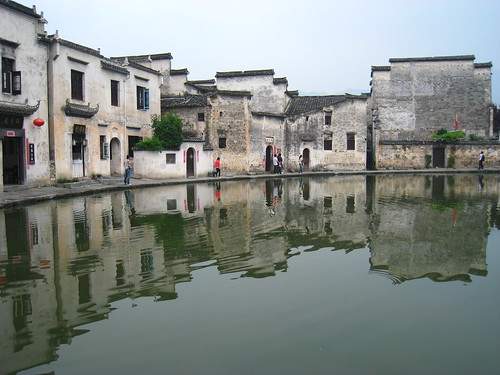 The Huizhou villages are wonderful time capsules of a bygone age. They are a complete contrast to the huge cities of China today. While they have not escaped tourism, some are listed as world heritage sites, they do still retain a unique charm. They do appear to be off the western tourist trail. It was the longest I went without seeing another westerner, five days, and the longest I went without coming across someone who could speak English. Although that is not to say the Chinese do not know about the villages and as with anywhere in China avoiding visiting over a weekend is probably a smart move.
The Huizhou villages are wonderful time capsules of a bygone age. They are a complete contrast to the huge cities of China today. While they have not escaped tourism, some are listed as world heritage sites, they do still retain a unique charm. They do appear to be off the western tourist trail. It was the longest I went without seeing another westerner, five days, and the longest I went without coming across someone who could speak English. Although that is not to say the Chinese do not know about the villages and as with anywhere in China avoiding visiting over a weekend is probably a smart move.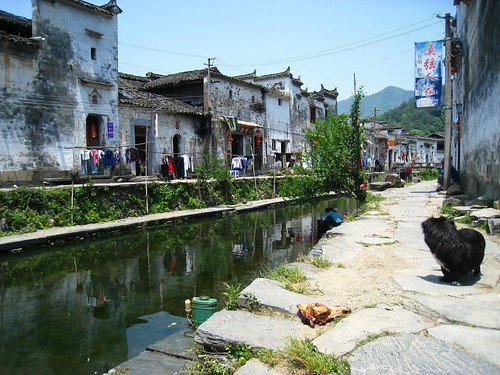 Although modern Chinese tourism has managed to get its claws into them. My first taste of Huizhou villages was around the city of Wuyuan. I hired a motorbike and driver for the day. My driver didn't speak a word of English but that didn't stop us negotiating a price for the day and where I wanted to visit. The only trouble I faced was that even though he didn't speak English and I didn't speak Chinese he did insist on leading me around all of the villages. While that did give me a chance to sit down and eat peanuts with some locals it also led us to having a falling out. We visited Qinghua for Rainbow Bridge (20Y). There was not a great deal to see and while the bridge is historic and pretty it would not be a great loss to skip it. It was interesting but there was not a great deal there and it was very touristy. I went to Big Likeng (20Y) which was amazing. Of all the Huizhou villages I have visited it was the least touristy and most atmospheric. I spent part of the afternoon sitting with the driver in someones home eating peanuts and drinking Green tea while watching earthquake coverage on the TV. The drive there and back was pretty good as well winding through the forest following the river. We drove to Qinghua for lunch. Lunch was a bit tricky as no one spoke English, eventually I managed to order a bowl of noodle soup with meat which turned out to be pretty good. The Chinese ability to down a bowl of noodles is a sight to behold. The afternoon stops at Si Xi and Yancun (36Y) were excellent, although me and the driver were having a falling out by this stage. I think this was down to me becoming increasingly frustrated with playing follow the leader with him. I spent the night in Little Likeng (30Y). We went on to Xian Qi (20Y) which was a glorified tourist market, though there was a pretty little village on a walk across fields. The whole day cost 160Y (including 40Y extra to visit Xian Qi). I stayed in a small basic guesthouse in Little Likheng for just 40Y (shared bathroom). You might assume that Little Likeng is smaller than Big Likeng, however, you would be wrong. Little Likeng is very pretty with a small river running through the centre. I was lucky enough to see the village ducks being rounded up along the river as the sun set. It is also one of the busiest places for tourists in the Wuyuan. I would recommend spending the night in Little Likeng so that you can appreciate the place before the tourists arrive (or after they have left).
Although modern Chinese tourism has managed to get its claws into them. My first taste of Huizhou villages was around the city of Wuyuan. I hired a motorbike and driver for the day. My driver didn't speak a word of English but that didn't stop us negotiating a price for the day and where I wanted to visit. The only trouble I faced was that even though he didn't speak English and I didn't speak Chinese he did insist on leading me around all of the villages. While that did give me a chance to sit down and eat peanuts with some locals it also led us to having a falling out. We visited Qinghua for Rainbow Bridge (20Y). There was not a great deal to see and while the bridge is historic and pretty it would not be a great loss to skip it. It was interesting but there was not a great deal there and it was very touristy. I went to Big Likeng (20Y) which was amazing. Of all the Huizhou villages I have visited it was the least touristy and most atmospheric. I spent part of the afternoon sitting with the driver in someones home eating peanuts and drinking Green tea while watching earthquake coverage on the TV. The drive there and back was pretty good as well winding through the forest following the river. We drove to Qinghua for lunch. Lunch was a bit tricky as no one spoke English, eventually I managed to order a bowl of noodle soup with meat which turned out to be pretty good. The Chinese ability to down a bowl of noodles is a sight to behold. The afternoon stops at Si Xi and Yancun (36Y) were excellent, although me and the driver were having a falling out by this stage. I think this was down to me becoming increasingly frustrated with playing follow the leader with him. I spent the night in Little Likeng (30Y). We went on to Xian Qi (20Y) which was a glorified tourist market, though there was a pretty little village on a walk across fields. The whole day cost 160Y (including 40Y extra to visit Xian Qi). I stayed in a small basic guesthouse in Little Likheng for just 40Y (shared bathroom). You might assume that Little Likeng is smaller than Big Likeng, however, you would be wrong. Little Likeng is very pretty with a small river running through the centre. I was lucky enough to see the village ducks being rounded up along the river as the sun set. It is also one of the busiest places for tourists in the Wuyuan. I would recommend spending the night in Little Likeng so that you can appreciate the place before the tourists arrive (or after they have left). 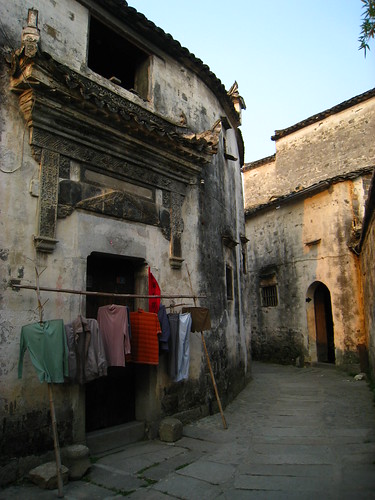
Hongcun is one of the UNESCO listed Huizhou villages. The whole village was originally laid out in the shape of an ox. The west end of the village, called Leigang Hill, resembles an ox head and that is where two huge trees stand like ox horns. At the front and rear of the village are four bridges that span a Jiyin stream and resemble four legs of the ox. The several hundred well-arranged houses form the body of the ox, and the 1,000-meter-long Jiyin stream that meanders through the village is regarded as its intestines. A crescent pond in the village is the ox‘s fourth stomach, its known as the postage stamp and is a great place for photographs. I arrived in Hongcun in the evening. I went wandering off into town to try and find somewhere to stay. I found one quite large hotel with no one inside. a woman appeared and after some gesticulating she led me to a room, we agreed on a price and I started unpacking. A guy arrived had a loud conversation with the woman and then gesticulated that I could not stay. I tried to understand why not and gesticulated back, but to no avail. I went off wandering again and ended up at the entrance to Hongcun (by the bridge) where there was a small but very modern hotel, with a price to match of 150Y for a double ensuite. It seems the hoteliers of Hongcun are rather unused to Westerners. After agreeing upon a price I then had to go through an elaborate charade to demonstrate my understanding the principles of a key deposit (that I return the key when I leave). A couple of Chinese students who spoke a bit of English were drafted in to help with the charades. I think the hotelier assumed I had just been parachuted into central China without staying anywhere else before. The great advantage of staying the night in the village is being able to explore the myriad of alleyways at dusk and dawn without the hordes of tourists. However, the Chinese do get up early so it does not take long for them to arrive. Some people might suggest that once you have seen one Huizhou village you have seen them all. While this isn't true it is nice to be able to break up the visit by going to Mekung. Mekung (20Y) is a very small Huizhou village high up on a ridge overlooking a bamboo covered valley. The walk through the bamboo forest to the village takes about an hour. It is beautiful, and while I was there very quiet even though Hongcun was busy.
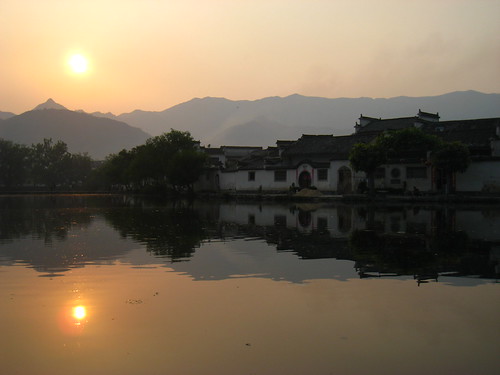 Wuyuan was a much bigger city than I realised when I returned to it from visiting the villages. I went to find the Post Office so I could send some postcards. I found the word for Post Office in the back of my guide book and headed out asking locals as I went. I eventually found the Post Office. The women working there were most surprised to see me walk in and were a bit flummoxed by what I could possibly want. After a while they cottoned on to my wanting stamps. In the meantime a crowd of customers surrounded me to see what was going on. A particularly short Chinese guy was most impressed by my height and that I was from England. I had some dumplings for lunch which again was a bit tricky. I walked into a dumpling shop. I was met by surprised stares. When they decided I want something to eat they got a pointing stick for me to use on the wall menu the only trouble being it was all in mandarin. I used the poking sticking to point at the food of the other customers. I also stumbled across the peculiar Chinese brothels. Peculiar because they are as obvious as anything sitting in the street barely disguised as hairdressers.
Wuyuan was a much bigger city than I realised when I returned to it from visiting the villages. I went to find the Post Office so I could send some postcards. I found the word for Post Office in the back of my guide book and headed out asking locals as I went. I eventually found the Post Office. The women working there were most surprised to see me walk in and were a bit flummoxed by what I could possibly want. After a while they cottoned on to my wanting stamps. In the meantime a crowd of customers surrounded me to see what was going on. A particularly short Chinese guy was most impressed by my height and that I was from England. I had some dumplings for lunch which again was a bit tricky. I walked into a dumpling shop. I was met by surprised stares. When they decided I want something to eat they got a pointing stick for me to use on the wall menu the only trouble being it was all in mandarin. I used the poking sticking to point at the food of the other customers. I also stumbled across the peculiar Chinese brothels. Peculiar because they are as obvious as anything sitting in the street barely disguised as hairdressers.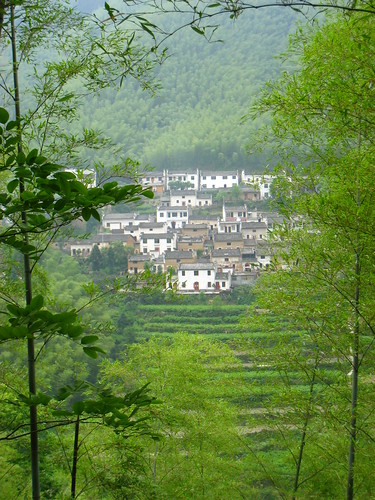 I reached Wuyuan from Wuhan. It was a convoluted journey. I caught a train from Wuchang to Jiulang., It was a hard seat in a double decker train which took three hours. I arrived at Jiulang only to have a problem finding the bus station. After wandering around for a while a girl approached me speaking English offering to help me. She helped me to find the bus station where I then caught a bus to Jindezhen which took another two and a half hours along a large empty dual carriageway with helpful signs in English such as 'Overspeeding Prohibited". I arrived in Jindezhen at the bus station opposite the train station to discover there no onward buses to Wuyuan. I walked around to the other bus station in town where I caught a bus to Wuyuan for the one and a half hour journey. The journey to Wuyuan was very beautiful once we left the urban sprawl of Jindezhen behind. I arrived in Wuyuan at 7pm. I was immediately latched on to by a moto driver wanting to take me to one of the nearby villages. I eventually lost him and settled into a hotel next to the bus station for 80Y. After spending the night at Little Likeng I caught a bus from Wuyuan to Tunxi which took two hours. I caught another bus straight on to Yixian (one hour, 12Y) and then another bus on to Hongcun (2Y). I caught a moto from Hongcun to Mekung (30Y). I got the moto driver to write down his mobile number so that I could call him from the guardhouse for the journey back to Hongcun. I then caught a bus to Yixian and a bus from there to Tunxi.
I reached Wuyuan from Wuhan. It was a convoluted journey. I caught a train from Wuchang to Jiulang., It was a hard seat in a double decker train which took three hours. I arrived at Jiulang only to have a problem finding the bus station. After wandering around for a while a girl approached me speaking English offering to help me. She helped me to find the bus station where I then caught a bus to Jindezhen which took another two and a half hours along a large empty dual carriageway with helpful signs in English such as 'Overspeeding Prohibited". I arrived in Jindezhen at the bus station opposite the train station to discover there no onward buses to Wuyuan. I walked around to the other bus station in town where I caught a bus to Wuyuan for the one and a half hour journey. The journey to Wuyuan was very beautiful once we left the urban sprawl of Jindezhen behind. I arrived in Wuyuan at 7pm. I was immediately latched on to by a moto driver wanting to take me to one of the nearby villages. I eventually lost him and settled into a hotel next to the bus station for 80Y. After spending the night at Little Likeng I caught a bus from Wuyuan to Tunxi which took two hours. I caught another bus straight on to Yixian (one hour, 12Y) and then another bus on to Hongcun (2Y). I caught a moto from Hongcun to Mekung (30Y). I got the moto driver to write down his mobile number so that I could call him from the guardhouse for the journey back to Hongcun. I then caught a bus to Yixian and a bus from there to Tunxi.
No comments:
Post a Comment